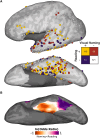Dissociation of reading and naming in ventral occipitotemporal cortex
- PMID: 38289871
- PMCID: PMC11224612
- DOI: 10.1093/brain/awae027
Dissociation of reading and naming in ventral occipitotemporal cortex
Abstract
Lesions in the language-dominant ventral occipitotemporal cortex (vOTC) can result in selective impairment of either reading or naming, resulting in alexia or anomia. Yet, functional imaging studies that show differential activation for naming and reading do not reveal activity exclusively tuned to one of these inputs. To resolve this dissonance in the functional architecture of the vOTC, we used focused stimulation to the vOTC in 49 adult patients during reading and naming, and generated a population-level, probabilistic map to evaluate if reading and naming are clearly dissociable within individuals. Language mapping (50 Hz, 2829 stimulations) was performed during passage reading (216 positive sites) and visual naming (304 positive sites). Within the vOTC, we isolated sites that selectively disrupted reading (24 sites in 11 patients) or naming (27 sites in 12 patients), and those that disrupted both processes (75 sites in 21 patients). The anteromedial vOTC had a higher probability of producing naming disruption, while posterolateral regions resulted in greater reading-specific disruption. Between them lay a multi-modal region where stimulation disrupted both reading and naming. This work provides a comprehensive view of vOTC organization-the existence of a heteromodal cortex critical to both reading and naming, along with a causally dissociable unimodal naming cortex, and a reading-specific visual word form area in the vOTC. Their distinct roles as associative regions may thus relate to their connectivity within the broader language network that is disrupted by stimulation, more than to highly selective tuning properties. Our work also implies that pre-surgical mapping of both reading and naming is essential for patients requiring vOTC resections, as these functions are not co-localized, and such mapping may prevent the occurrence of unexpected deficits.
Keywords: alexia; anomia; cortical stimulation mapping; dyslexia; language; reading.
© The Author(s) 2024. Published by Oxford University Press on behalf of the Guarantors of Brain. All rights reserved. For commercial re-use, please contact reprints@oup.com for reprints and translation rights for reprints. All other permissions can be obtained through our RightsLink service via the Permissions link on the article page on our site—for further information please contact journals.permissions@oup.com.
Conflict of interest statement
The authors report no competing interests.
Figures




Similar articles
-
Converging evidence for functional and structural segregation within the left ventral occipitotemporal cortex in reading.Proc Natl Acad Sci U S A. 2018 Oct 16;115(42):E9981-E9990. doi: 10.1073/pnas.1803003115. Epub 2018 Sep 17. Proc Natl Acad Sci U S A. 2018. PMID: 30224475 Free PMC article.
-
Intraoperative localization and preservation of reading in ventral occipitotemporal cortex.J Neurosurg. 2022 Apr 8;137(6):1610-1617. doi: 10.3171/2022.2.JNS22170. Print 2022 Dec 1. J Neurosurg. 2022. PMID: 35395633 Free PMC article.
-
The left occipitotemporal system in reading: disruption of focal fMRI connectivity to left inferior frontal and inferior parietal language areas in children with dyslexia.Neuroimage. 2011 Feb 1;54(3):2426-36. doi: 10.1016/j.neuroimage.2010.10.002. Epub 2010 Oct 8. Neuroimage. 2011. PMID: 20934519
-
A lexical semantic hub for heteromodal naming in middle fusiform gyrus.Brain. 2018 Jul 1;141(7):2112-2126. doi: 10.1093/brain/awy120. Brain. 2018. PMID: 29860298 Free PMC article.
-
Neural Responses of the Anterior Ventral Occipitotemporal Cortex in Developmental Dyslexia: Beyond the Visual Word Form Area.Invest Ophthalmol Vis Sci. 2019 Mar 1;60(4):1063-1068. doi: 10.1167/iovs.18-26325. Invest Ophthalmol Vis Sci. 2019. PMID: 30897621
Cited by
-
Non-right-handedness, male sex, and regional, network-specific, ventral occipito-temporal anomalous lateralization in adults with a history of reading disability.Cortex. 2025 Feb;183:116-130. doi: 10.1016/j.cortex.2024.09.018. Epub 2024 Nov 19. Cortex. 2025. PMID: 39631179
-
Memorability of novel words correlates with anterior fusiform activity during reading.Nat Commun. 2025 Feb 23;16(1):1902. doi: 10.1038/s41467-025-57220-y. Nat Commun. 2025. PMID: 39988589 Free PMC article.
-
Revealing the co-existence of written and spoken language coding neural populations in the visual word form area.Imaging Neurosci (Camb). 2025 Mar 31;3:imag_a_00524. doi: 10.1162/imag_a_00524. eCollection 2025. Imaging Neurosci (Camb). 2025. PMID: 40800829 Free PMC article.
-
Unique longitudinal contributions of sulcal interruptions to reading acquisition in children.bioRxiv [Preprint]. 2024 Jul 30:2024.07.30.605574. doi: 10.1101/2024.07.30.605574. bioRxiv. 2024. PMID: 39131390 Free PMC article. Preprint.
References
MeSH terms
Grants and funding
LinkOut - more resources
Full Text Sources

